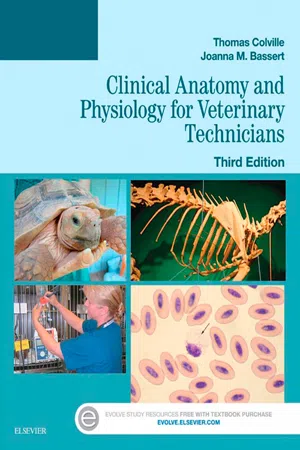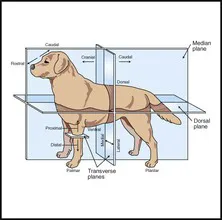
eBook - ePub
Clinical Anatomy and Physiology for Veterinary Technicians
- 656 pages
- English
- ePUB (mobile friendly)
- Available on iOS & Android
eBook - ePub
Clinical Anatomy and Physiology for Veterinary Technicians
About this book
- NEW! Vocabulary Fundamentals list of terms at the beginning of each chapter introduce readers to new scientific terms and their pronunciations.
Frequently asked questions
Yes, you can cancel anytime from the Subscription tab in your account settings on the Perlego website. Your subscription will stay active until the end of your current billing period. Learn how to cancel your subscription.
No, books cannot be downloaded as external files, such as PDFs, for use outside of Perlego. However, you can download books within the Perlego app for offline reading on mobile or tablet. Learn more here.
Perlego offers two plans: Essential and Complete
- Essential is ideal for learners and professionals who enjoy exploring a wide range of subjects. Access the Essential Library with 800,000+ trusted titles and best-sellers across business, personal growth, and the humanities. Includes unlimited reading time and Standard Read Aloud voice.
- Complete: Perfect for advanced learners and researchers needing full, unrestricted access. Unlock 1.4M+ books across hundreds of subjects, including academic and specialized titles. The Complete Plan also includes advanced features like Premium Read Aloud and Research Assistant.
We are an online textbook subscription service, where you can get access to an entire online library for less than the price of a single book per month. With over 1 million books across 1000+ topics, we’ve got you covered! Learn more here.
Look out for the read-aloud symbol on your next book to see if you can listen to it. The read-aloud tool reads text aloud for you, highlighting the text as it is being read. You can pause it, speed it up and slow it down. Learn more here.
Yes! You can use the Perlego app on both iOS or Android devices to read anytime, anywhere — even offline. Perfect for commutes or when you’re on the go.
Please note we cannot support devices running on iOS 13 and Android 7 or earlier. Learn more about using the app.
Please note we cannot support devices running on iOS 13 and Android 7 or earlier. Learn more about using the app.
Yes, you can access Clinical Anatomy and Physiology for Veterinary Technicians by Thomas P. Colville,Joanna M. Bassert in PDF and/or ePUB format, as well as other popular books in Medicine & Veterinary Medicine. We have over one million books available in our catalogue for you to explore.
Information
1
Introduction to Anatomy and Physiology
Thomas Colville
Learning Objectives
When you have completed this chapter, you will be able to:
1. Define the terms anatomy and physiology.
2. Differentiate between microscopic and macroscopic anatomy.
3. Differentiate between the study of regional anatomy and the study of systemic anatomy.
4. Describe the four anatomic planes of reference.
5. List and describe the anatomic terms of direction.
6. List and describe common regional terms for the body.
7. List the components of the dorsal body cavity.
8. List the components of the ventral body cavity.
9. List the four basic types of body tissue.
10. Define homeostasis.
Vocabulary Fundamentals
Adipose ahd-ih-pōs
Anatomy ah-naht-ah-mē
Anterior ahn-teer-ē-ɘr
Barrel beɘr-uhl
Bilateral symmetry bī-laht-ɘr-ahl sihm-ih-trē
Brisket brihs-kiht
Cannon kahn-nuhn
Cardiac muscle kahr-dē-ahck muhs-uhl
Carpus kahr-puhs
Caudal kaw-dahl
Connective tissue kuh-nehck-tihv tihsh-yoo
Cranial krā-nē-ahl
Cranium krā-nē-uhm
Deep dēp
Digestive system dih-jehs-tihv sihs-tehm
Distal dihs-tahl
Dorsal dohr-sahl
Dorsal body cavity dohr-sahl boh-dē kahv-ih-tē
Dorsal plane dohr-sahl plān
Epithelial tissue ehp-ih-thē-lē-ahl tihsh-yoo
Equilibrium ē-kwuh-lihb-rē-uhm
External ehcks-tɘr-nahl
Fetlock feht-lohck
Fight or flight system fīt or flīt sihs-tehm
Flank flahngk
Gastrointestinal (GI) tract gahs-trō-ihn-tehs-tih-nahl trahkt
Gross anatomy grōs ah-naht-ah-mē
Health hehlth
Hock hohck
Homeostasis hō-mē-ō-stā-sihs
Inferior ihn-feer-ē-ɘr
Inflammation ihn-fluh-mā-shuhn
Internal ihn-tɘr-nahl
Knee—carpus of hoofed animals nē—kahr-puhs of hooft ahn-uh-muhlz
Lateral laht-ɘr-ahl
Macroscopic anatomy mah-krō-skohp-ihck ah-naht-ah-mē
Medial mē-dē-ahl
Medial plane mē-dē-ahl plān
Microscopic anatomy mī-krō-skohp-ihk ah-naht-ah-mē
Muscle tissue muhs-uhl tihsh-yoo
Organ ohr-gahn
Palmar pahl-mɘr
Parietal layer pah-rī-eh-tahl lā-ɘr
Pastern pahs-tɘrn
Physiology fihz-ē-ohl-uh-jē
Plane of reference plān of rehf-ɘr-uhnz
Plantar plahn-tahr
Pleura ploor-ah
Poll pōl
Posterior pō-steer-ē-ɘr
Proximal prohck-sih-mahl
Regional anatomy rē-juhn-ahl ah-naht-ah-mē
Rostral rohs-trahl
Sagittal plane sahj-ih-tahl plān
Skeletal muscle skehl-ih-tahl muhs-uhl
Smooth muscle smooth muhs-uhl
Spinal canal spī-nahl kuh-nahl
Stifle stī-fuhl
Superficial soo-pɘr-fihsh-ahl
Superior suh-peer-ē-ɘr
System sihs-tehm
Systematic anatomy sihs-tuh-maht-ihck ah-naht-ah-mē
Tailhead tā-uhl-hehd
Tarsus tahr-suhs
Thorax thohr-ahx
Tissue tihsh-yoo
Transverse plane trahnz-vɘrs plān
Ventral vehn-trahl
Ventral body cavity vehn-trahl boh-dē kahv-ih-tē
Viscera vih-sɘr-ah
Visceral layer vih-sɘr-ahl lā-ɘr
Withers wihth-ɘrz
Xiphoid process zī-foyd proh-sehs

Introduction
Life is a tricky proposition. It is difficult, messy, fragile, and a lot of work. The bodies of living animals have to be organized just right and maintained within very narrow limits to allow the hectic choreography of life to unfold throughout their lives.
We don't usually think of animals as living mechanisms, but the study of anatomy and physiology is really the study of the animal machine, what makes it up, and how the whole thing works. The language of anatomy and physiology uses terms like cells, tissues, organs, and systems, but we're really talking about the component parts of this living machine. These living parts are amazingly intricate and their functions delicately interrelated. As veterinary health care professionals, we must understand how animals are put together and how their bodies work. Fortunately, the animal body is fascinating to study in and of itself, but even more so when we appreciate how important normal anatomy and physiology are to animal health.
The various parts of the body must work together in near-perfect harmony to maintain the life and well-being of an animal. The interesting part of this truth is that the apparently simple and automatic states of life and health are not as they seem. Life is not simple, and health is not automatic. Life is extraordinarily complicated, and health is the result of numerous things going just right. At first glance it seems as though health is the normal state of affairs, and dis...
Table of contents
- Cover image
- Title Page
- Table of Contents
- Copyright
- Dedication
- Contributors
- Preface
- Acknowledgments
- Vet Tech Threads
- 1 Introduction to Anatomy and Physiology
- 2 Chemical Basis for Life*
- 3 Anatomy of the Cell
- 4 Cell Physiology
- 5 Tissues
- 6 The Integument and Related Structures
- 7 The Skeletal System
- 8 Muscular System
- 9 Nervous System
- 10 Sense Organs
- 11 Endocrine System
- 12 Blood, Lymph, and Lymph Nodes
- 13 Immunity and Defense
- 14 The Cardiovascular System
- 15 The Respiratory System
- 16 Digestive System
- 17 Nutrients and Metabolism
- 18 The Urinary System
- 19 The Reproductive System
- 20 Pregnancy, Development, and Lactation
- 21 Avian Anatomy and Physiology
- 22 Amphibian and Reptilian Anatomy and Physiology
- Glossary
- Index